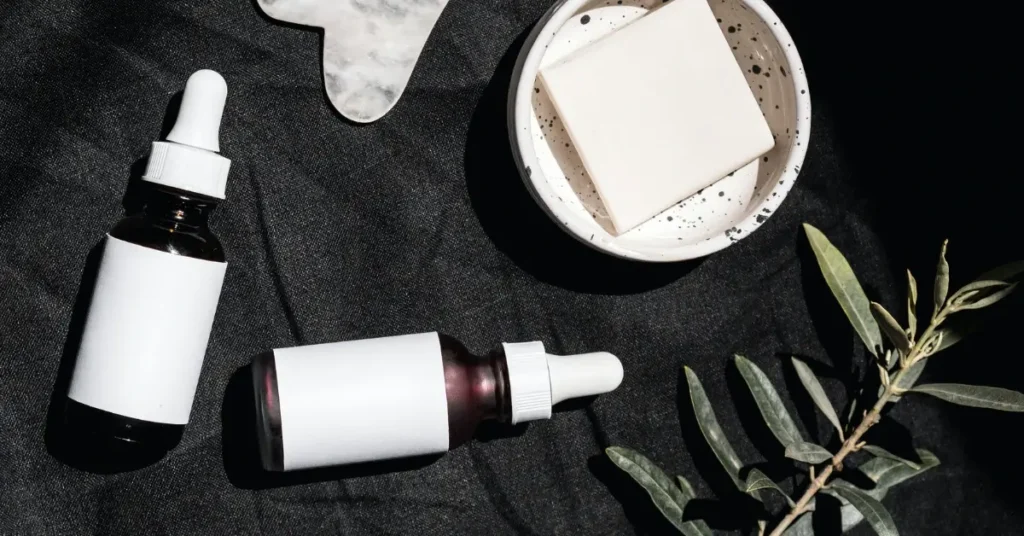Are you exhausted from navigating through countless discussions about ceramide vs. niacinamide in skincare? Identifying the ideal routine may appear to be a daunting task. But worry not, as I have undertaken the difficult efforts for you!
Brace yourself for a skincare revelation – the ultimate solution lies in combining these two powerhouse ingredients. Allow me to shed light on the secret to achieving unparalleled results.
Get ready to embrace the best of both worlds – ceramide and niacinamide working in perfect harmony. You won’t want to miss out on this game-changing discovery. So, let’s delve into the why behind this dynamic combination and unlock the path to your most radiant and flawless complexion yet! Trust me; this is one journey you won’t want to miss!
Table of Contents
Ceramide vs Niacinamide
Ceramides are lipids that help to maintain our skin’s natural barrier, keeping it hydrated and protected from external irritants. On the other hand, niacinamide – also known as vitamin B3 – is a multitasking ingredient that tackles a variety of skin concerns ranging from acne and inflammation to fine lines and hyperpigmentation. When looking at ceramide vs niacinamide, I realized that each ingredient shines in its own unique way, addressing different aspects of skin health.
By incorporating both ceramides and niacinamide into my skincare routine, I found that my skin stays moisturized, radiant, and more resilient against potential irritants. In this friendly discussion, I will share more about the benefits of each ingredient and how combining them can ultimately lead to healthier, more vibrant skin.
Ceramide Overview
When it comes to skincare and the never-ending quest for a balanced complexion, the debate of ceramide vs niacinamide often pops up. As someone who has struggled with a myriad of skin issues, I thought it would be helpful to get an engaging and user-friendly scoop on ceramides to shed light on their potential.

Ceramides are a type of lipid, naturally occurring in the epidermis of our skin. They are part of a larger subgroup of lipids called sphingolipids and play a crucial role in maintaining skin hydration and preventing harmful bacteria from invading the dermis layers. Personally, my experience using ceramide-based products has led me to notice improvements in my skin’s overall texture and tone, which is one of the known benefits of ceramides.
Some other benefits include:
- Enhancing moisture retention
- Strengthening the skin’s barrier function
- Minimizing the appearance of fine lines and wrinkles
Possible Side Effects

Ceramides, in general, are considered quite safe and well-tolerated by most skin types. However, since I am not a professional dermatologist, anyone using ceramide-based products should closely monitor their skin for any possible reactions.
In the rare cases that reactions occur, some side effects may include:
- Skin irritation or redness
- Allergic reaction
- Breakouts, especially for acne-prone skin
When comparing ceramide vs niacinamide, it is essential to weigh the pros and cons of each ingredient and observe how your skin responds to them. Moreover, consulting with a dermatologist or skincare professional can help you make the best decision for your skincare routine.
Niacinamide Overview
When it comes to skincare, the debate of ceramide vs niacinamide is a popular topic. As someone who has experienced the benefits of both, I’d like to give you a brief introduction to niacinamide.
Function and Benefits
Niacinamide, also known as nicotinamide, is a water-soluble form of Vitamin B3. It plays a crucial role in maintaining healthy skin and offers numerous advantages, such as:
- Building keratin: This protein helps keep your skin firm and healthy.
- Lipid barrier support: Niacinamide assists in growing a ceramide (lipid) barrier, leading to improved skin hydration and protection.
- Reducing inflammation: It helps calm irritated skin and minimize the appearance of dark spots, hyperpigmentation, and acne scarring.
- Enhancing skin texture and tone: Niacinamide is suitable for all skin types, even sensitive or acne-prone skin, making it a versatile choice for most people.
I’ve personally experienced improved skin texture and a significant reduction in inflammation when using niacinamide regularly in my skincare routine.
Possible Side Effects
Although niacinamide is generally well-tolerated, it’s important to be aware of potential side effects. Some people may experience:
- Mild irritation or redness
- Dryness or flaking
- Increased sensitivity to the sun
To avoid possible side effects, it’s best to patch-test a niacinamide product on a small area of your skin before incorporating it fully into your skincare routine.
Comparing Ceramide and Niacinamide

When diving into the world of skincare, you might wonder about ceramide vs niacinamide. These ingredients have captured my attention, as both play key roles in optimizing skin health. In this section, I’ll explore their efficacy in skincare and compatibility with other ingredients.
Efficacy in Skin Care
Ceramides are essential components of the outermost skin layer, the stratum corneum. The “bricks and mortar” analogy can help us understand their role in maintaining the skin barrier, keeping it hydrated and protected from environmental irritants. The moisturizing properties of ceramides make them especially suitable for individuals with dry or sensitive skin.
On the other hand, niacinamide is a multipurpose ingredient with a robust profile of benefits, supporting a broad range of skincare goals. It helps with skin toning and light hydration. Additionally, niacinamide offers brightening effects, reduces redness, and supports healthy collagen production.
| Ceramides | Niacinamide |
|---|---|
| Hydrate and protect skin | Tone and provide light hydration |
| Ideal for dry or sensitive skin | Suitable for various skin types |
| Maintain skin barrier | Support healthy collagen production |
Compatibility with Other Ingredients
The great news is that both ceramides and niacinamide can be used together since they complement each other in enhancing skin appearance and hydration1. This dynamic duo can contribute to immediate visible results and long-term skin improvement.
Aside from pairing with one another, niacinamide is known for its versatility and compatibility with various other skincare ingredients. Ceramides, while not as versatile, still work well alongside other moisturizing agents like hyaluronic acid and glycerin without causing any conflicts.
How to Choose the Right One: Ceramide vs Niacinamide

As someone who’s always looking to improve my skincare routine, I’ve come across the great debate of ceramide vs niacinamide. Both of these ingredients are essential for maintaining healthy and radiant skin, but the question remains: which one is best for you? In this section, let’s dive into the factors that can help you make an informed decision.
Skin Types
When it comes to skin types, both ceramide, and niacinamide are quite versatile. In fact, niacinamide suits all skin types, including sensitive or acne-prone skin. On the other hand, ceramides are particularly beneficial for individuals with dry, sensitive, or aging skin. They help reinforce the skin’s natural barrier, which is essential for retaining moisture and protecting your skin from environmental stressors.
Concerns
When considering your skin concerns, it’s essential to understand the specific benefits of each ingredient:
- Niacinamide: This powerhouse ingredient has multiple benefits for the skin, such as minimizing the appearance of dark spots, hyperpigmentation, and acne scarring. It also supports a more even skin texture and tone.
- Ceramides: These lipid molecules are naturally found in our skin and play a vital role in maintaining skin health. They are crucial for retaining moisture, helping to alleviate dry and sensitive skin conditions. Additionally, ceramides work to strengthen the skin barrier, providing a plump and youthful appearance.
Combining Ceramide and Niacinamide
5 starts because thats how good it is. Contained ceramide and niacinamide. My very favourite ingredients. Very lightweight and non comedogenic! Definitely my favourite brand! #reviewbyKD
— Kd #StayAtHome (@Kzdlny) February 27, 2019
As a skincare enthusiast, I’ve always been curious about the differences between ceramide and niacinamide. But have you ever wondered how these ingredients interact when used together? In this section, we’ll delve into the benefits, possible side effects, and a step-by-step guide on how to combine ceramide and niacinamide for maximum results.
Benefits
Using ceramide and niacinamide together can work wonders for your skin. Combining these ingredients helps soothe sensitive or inflamed skin, contributing to immediate, visible results and long-term improvement of your skin’s appearance and hydration. Ceramides are crucial for maintaining the skin’s natural moisture barrier, while niacinamide, also known as Vitamin B3, offers benefits like brightening and managing mild acne-prone skin.
Possible side effects
There aren’t many reported side effects of using ceramide and niacinamide together. However, it’s important to note that niacinamide shouldn’t be combined with certain ingredients like Vitamin C and hydroxy acids. I recommend patch-testing products with these ingredients before applying them all over your face to reduce the risk of irritation.
How to Combine Ceramide and Niacinamide: Step-by-Step

- Cleanse: Start by gently cleansing your face with a gentle, fragrance-free cleanser.
- Toner: If you use a toner, apply it now. Preferably one that is alcohol-free and contains hydrating ingredients.
- Serum: Apply a serum that contains niacinamide. Look for one with at least 2-5% concentration.
- Moisturizer: Lock in hydration with a moisturizer that contains ceramides. Use one that is suitable for your skin type.
- SPF: Don’t forget to apply sunscreen with broad-spectrum protection during the day!
By following these steps, I believe that you can make the most of the ceramide vs niacinamide debate and embrace the advantages of using them together in your skincare routine. Happy skincare!
Ceramide vs Niacinamide: A Recap
When it comes to skincare, the debate between ceramide and niacinamide can be pretty intense. Both of these powerful ingredients have vast benefits, and it can be overwhelming to decide which one is better for you. But fear not, I’m here to help break down the differences and advantages of both!
Ceramides are lipids that help form the skin’s barrier, protecting it from environmental stressors and locking in moisture. Niacinamide, on the other hand, is a form of vitamin B3 known for reducing inflammation, calming irritated skin, and improving skin texture and tone.
Here’s a quick comparison of ceramides and niacinamide:
| Ceramides | Niacinamide |
|---|---|
| Helps form the skin’s barrier | Reduces inflammation |
| Protects skin from environmental stressors | Calms irritated skin |
| Retains moisture | Improves skin texture and tone |
In my personal experience, I’ve found that combining ceramides and niacinamide in my skincare routine has produced the best results. While ceramides help repair and protect my skin’s barrier, niacinamide works to calm any irritation and even out my complexion, making my skin feel and look healthy.
So, if you’re trying to decide whether to choose ceramides or niacinamide in your skincare regimen, why not use both? Combining these two ingredients can help you achieve radiant, glowing skin – and let’s be honest, who doesn’t want that?
Give it a shot and let me know how it works for you! Just remember, always patch-test new products before applying them to your entire face, and consult your dermatologist if you have any concerns.
FAQ

Does niacinamide and ceramides work together?
Yes, niacinamide and ceramides can work together synergistically. Niacinamide helps regulate sebum production and improves the skin’s barrier function, while ceramides strengthen and moisturize the skin’s barrier. Using products with both ingredients can promote healthy, hydrated, and well-protected skin.
Do you use ceramides or niacinamide first?
You can use niacinamide first, followed by ceramides. Niacinamide is water-soluble and is typically applied before oil-based products like ceramides. This order allows both ingredients to be effectively absorbed and work optimally on your skin.
Should I use ceramide everyday?
Yes, you can use ceramides daily. Ceramides are beneficial for maintaining a healthy skin barrier and preventing moisture loss. Incorporating them into your daily skincare routine can help keep your skin hydrated, protected, and less prone to dryness or sensitivity.
Do ceramides make you look younger?
Ceramides help improve the skin’s barrier function, retain moisture, and enhance overall skin health, which can contribute to a more youthful appearance. While they may not directly reverse aging, they can support skin resilience and hydration, leading to a healthier and plumper complexion.
If you liked this blog article about the topic: “Ceramide vs Niacinamide: Making The Right Decision In 2023”, don’t forget to leave us a comment down below to tell us about your experience.






